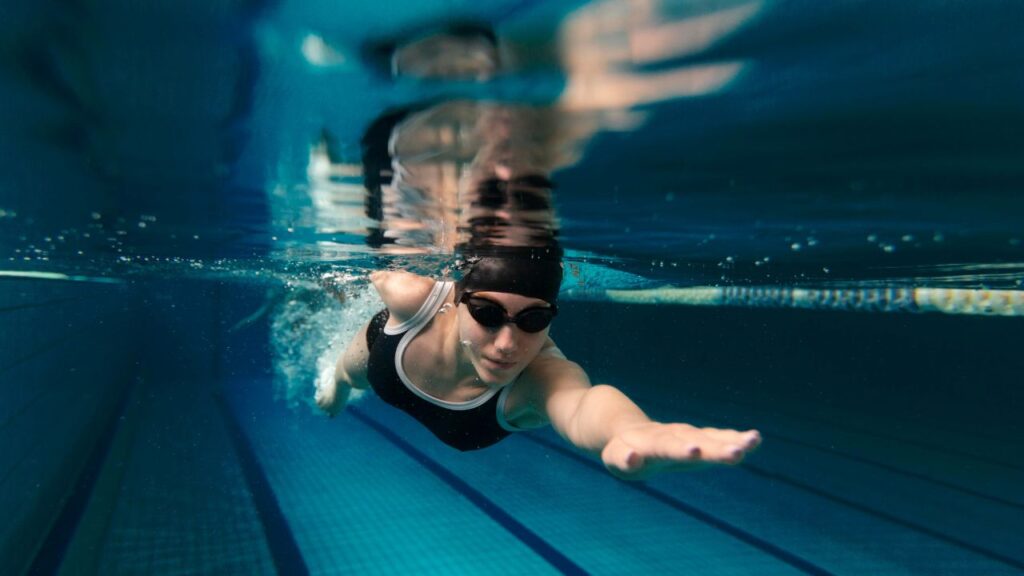Swimming is a great way to stay fit and active while also having fun. But if you’re looking to increase your swimming endurance in order to reach the next level of performance, you’ll need some guidance.
If you’re ready to take your swimming game to the next level, then this guide is for you. Here we will give an in-depth breakdown of how to increase swimming endurance. So, strap on your swim cap, and let’s get started.

Reasons for Increasing Swimming Endurance
Are you looking to become a better swimmer? Have you been swimming for a while, but feel like you need to increase your endurance? If yes, you’ve come to the right place. Increasing your swimming endurance not only makes the sport more enjoyable, but it also helps you maximize performance.
Regularly boosting your swimming stamina can help minimize fatigue and improve your overall efficiency. In addition, increasing your endurance can help with pacing and cut down on rest periods between sets. This ultimately leads to quicker completion times in races and workouts as well as improved conditioning for longer distance events.
Beyond just improving performance, increasing your endurance also reduces the risk of injury. With greater strength and muscle capacity, muscles are better prepared for handling stress from long-duration swimming sessions and intense workouts. This helps prevent muscle soreness and strains, which keeps you in the pool longer.
Techniques to Boost Swimming Endurance
If you’re looking for ways to increase your swimming endurance, then you’re in the right place! Here are some techniques you can use to boost your endurance so that you can swim for longer distances without feeling as fatigued.
Increase Your Swimming Frequency
The most effective way to build your swimming endurance is to gradually increase the frequency of your swimming sessions. As your body gets used to the activity, it will be able to perform for longer periods of time with less effort. Start off by swimming two or three times per week and then add additional days as needed. Be sure to take rest days in between so that you don’t overdo it and end up exhausted or injured.
Utilize Interval Training
Interval training is a great way to improve your overall fitness level and swimming technique while also increasing your endurance. The basic idea behind interval training is to alternate between short bursts of high intensity and longer stretches of lower intensity.
For example, you might swim 25 meters at full speed, followed by 75 meters at an easy pace. This type of training will help improve both aerobic capacity and muscular strength, allowing you to swim farther with less fatigue.
Focus on Your Technique
Swimming with good technique helps conserve energy and prevents unnecessary fatigue. Make sure that you are maintaining good body position in the water, using proper stroke mechanics, and breathing correctly. All these little details can make a huge difference when it comes to increasing your endurance in the pool.
How to Increase Swimming Endurance- Step-by-Step Guideline
Swimming is an excellent form of exercise that offers numerous health benefits. It is a low-impact, full-body workout that can help improve cardiovascular health, build muscular strength, and enhance overall fitness.
However, like any other physical activity, swimming requires endurance to be able to swim for longer durations without getting exhausted. Here’s a step-by-step guideline on how to increase your swimming endurance:
Step 1: Start with a Proper Warm-up
Before diving into the pool, it’s essential to warm up your muscles and joints to prevent injury and prepare your body for the swim ahead. A good warm-up routine can involve light jogging or cycling, stretching exercises that focus on the shoulders, hips, and back, and a few laps of easy swimming.
Step 2: Focus on the Technique
Swimming efficiently is crucial for building endurance, as it conserves energy and reduces fatigue. Proper technique involves streamlined body positioning, breathing techniques, and stroke efficiency. You can work on your technique by taking swimming lessons or asking a coach to watch and correct your form.
Step 3: Build Endurance through Interval Training
Interval training involves alternating periods of high-intensity effort with periods of low-intensity effort, which helps build cardiovascular endurance. An example of interval training in swimming could be alternating between a few laps of high-intensity freestyle followed by an easy lap of breaststroke, then repeating the sequence several times.
Step 4: Increase Distance Gradually
Gradually increasing the distance swam is an effective way to build endurance. Start by setting achievable goals, such as adding one or two laps to your routine each week, and gradually increase the distance as your endurance improves.
Step 5: Incorporate Strength Training
Strength training can help improve muscular endurance, which is crucial for swimming. Exercises that focus on the muscles used in swimming, such as the back, shoulders, and arms, can help improve your overall strength and endurance.
Step 6: Practice Breathing Techniques
Efficient breathing is essential for endurance swimming. Focus on exhaling completely underwater and inhaling quickly and deeply as soon as your face comes out of the water. You can also practice breathing on both sides to improve your overall swimming efficiency.
Step 7: Incorporate Rest and Recovery
Rest and recovery are crucial for building endurance in any physical activity, including swimming. Ensure that you’re getting enough sleep and taking rest days to allow your body to recover and repair itself after swimming sessions.
Building swimming endurance requires a combination of proper technique, interval training, gradual distance increases, strength training, breathing techniques, and adequate rest and recovery.
By following these step-by-step guidelines, you can improve your swimming endurance and enjoy the many health benefits that swimming has to offer.
Mental Preparation for Increased Swimming Endurance
Swimming is a physically demanding sport that requires not only physical preparation but also mental preparation to increase endurance. Mental preparation involves preparing your mind to cope with the physical demands of swimming, overcoming mental barriers, and maintaining focus and motivation during training sessions. Here are some tips for mental preparation to increase swimming endurance:
Set Realistic Goals
Setting realistic goals is an essential aspect of mental preparation for increasing swimming endurance. Goals should be specific, measurable, attainable, relevant, and time-bound (SMART). Setting goals that are too high or unrealistic can be demotivating, while setting achievable goals can help build confidence and motivation.
Visualize Success
Visualization is a powerful technique that can help improve mental preparation for swimming endurance. Visualize yourself swimming with ease, feeling strong and focused, and finishing each lap with confidence. This technique can help you develop a positive mindset and overcome mental barriers.
Practice Positive Self-Talk
Positive self-talk involves using positive affirmations and thoughts to maintain a positive mindset. It can help you overcome negative thoughts and self-doubt, increase motivation, and improve confidence. Examples of positive self-talk for swimming endurance could be “I am strong and capable,” “I can swim further than I think,” or “I am making progress towards my goals.”
Manage Anxiety and Stress
Anxiety and stress can negatively impact mental preparation for swimming endurance. Techniques such as deep breathing, meditation, and mindfulness can help manage anxiety and stress levels. It is also essential to ensure adequate rest and recovery and to seek support from a mental health professional if necessary.
Focus on Technique
Focusing on technique is not only crucial for physical preparation but also for mental preparation for swimming endurance. By focusing on proper technique, you can conserve energy and swim more efficiently, reducing the likelihood of mental fatigue and burnout.
Break Up Your Swim into Smaller Goals
Breaking up your swim into smaller goals can help make the task of increasing endurance seem more manageable. Rather than focusing on the total distance or time, focus on smaller milestones such as each lap or set. Celebrating each milestone can help build confidence and motivation.
Stay Motivated
Maintaining motivation is key to mental preparation for swimming endurance. Find ways to stay motivated, such as listening to music, swimming with a friend or coach, or incorporating variety into your swim routine. Celebrating progress and achievements can also help maintain motivation and build confidence.
Mental preparation is just as important as physical preparation for increasing swimming endurance. By maintaining these tips, you can improve your mental preparation and achieve your swimming endurance goals.
Final Thought
Increasing swimming endurance requires a combination of physical and mental preparation. By incorporating some useful techniques, you can improve your physical preparation. Setting realistic goals, visualizing success, practicing positive self-talk, managing anxiety and stress, breaking up your swim into smaller goals, and staying motivated can improve your mental preparation.
With dedication and consistency, you can increase your swimming endurance, enjoy the benefits of this excellent form of exercise, and feel confident and strong in the water. So, dive in and start improving your swimming endurance today.
Hopefully, this small effort will be helpful for all of you to learn how to increase swimming endurance. Thank you all.
